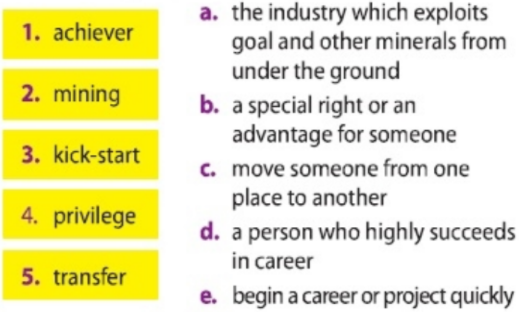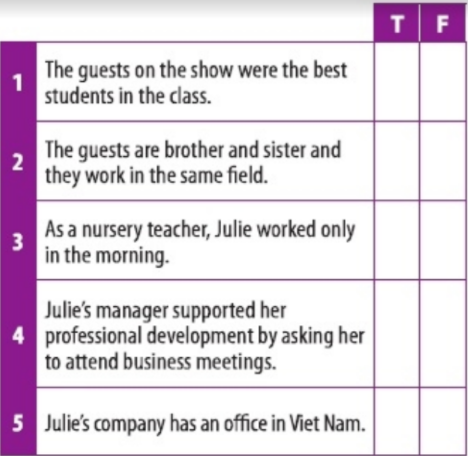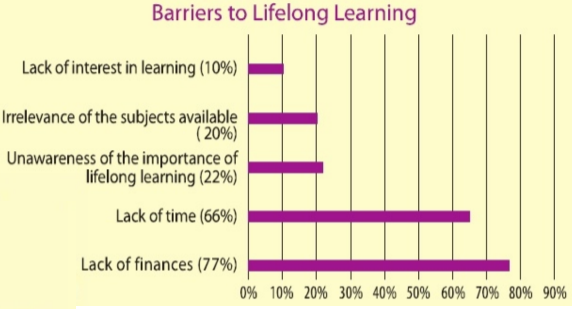Đừng bỏ lỡ những tính năng hấp dẫn của Baitap365.com
Unit 10: Lifelong Learning - Học suốt đời
Skills - trang 62 Unit 10 SGK tiếng Anh 12 mới
Communication and Culture - trang 66 Unit 10 SGK tiếng Anh 12 mới Looking back - trang 68 Unit 10 SGK tiếng Anh 12 mới Project - trang 69 Unit 10 SGK tiếng Anh 12 mới Language - trang 60 Unit 10 SGK tiếng Anh 12 mới Getting Started - trang 58 Unit 10 SGK tiếng Anh 12 mới Luyện tập từ vựng Unit 10 Tiếng Anh 12 mới Ngữ pháp: Conditional type 3 and Mixed conditional of type 2 and type 3 – Unit 10. Lifelong learning - Tiếng Anh 12 mới Vocabulary - Phần từ vựng - Unit 10 tiếng Anh 12 mớiSkills - trang 62 Unit 10 SGK tiếng Anh 12 mới
Tổng hợp các bài tập trong phần Skills - trang 62 Unit 10 SGK tiếng anh 12 mới
Reading - 1
Notes on lifelong learning
(Những ghi chú về học tập suốt đời)
1. Work with a partner. Ask and answer the questions below.
(Làm việc với một người bạn. Hỏi và trả lời những câu hỏi phía dưới.)
1. What do you think can facilitate lifelong learning?
(Bạn nghĩ gì có thể tạo điều kiện cho việc học suốt đời?)
2. How can people practise lifelong learning?
(Làm thế nào để người ta có thể học tập suốt đời?)
Reading - 2
2. Read the text about lifelong learning and choose a heading for each paragraph.
(Đọc văn bản về học tập suốt đời và chọn một tiêu đề cho mỗi đoạn.)
a. Forms of lifelong learning (Hình thức học tập suốt đời)
b. Aims of lifelong learning (Mục đích học tập suốt đời)
c. Defining lifelong learning (Xác định học tập suốt đời)
d. The difference between compulsory education and lifelong learning
(Sự khác biệt giữa giáo dục bắt buộc và học tập suốt đời)
1. ________
‘Lifelong learning' is the pursuit of knowledge throughout life. In other words, learning is not confined to the classroom environment and school subjects. Instead, people can learn throughout their adulthood, even in old age and in a variety of situations, particularly in their daily interactions with others and with the world around them. Lifelong learning must be voluntary and self-motivated. Therefore, lifelong learners should have a strong desire to learn and explore the world.
2. ________
Lifelong learning is facilitated by e-learning platforms. Education is now no longer offered only by ‘bricks and mortar' institutions. Online courses have instead enabled lifelong learning by providing learners, teachers, and course providers with much more exibility in terms of learning time, place, pace, and style. Learners, for instance, can now have the course content taught to them by a school located miles away from where they live or work. In addition, young parents can select their group meeting time late in the evening when their children have gone to bed.
3. ________
Most importantly, lifelong learning should be regarded as an attitude to learning for self-improvement rather than a pathway to qualifications. This means the ultimate aim is to better yourself for personal and/or professional development rather than for some certificate to decorate your CV. This type of lifelong learning may not necessarily take place as part of a course. It may be done very informally in any area of interest and at your convenience, as long as it is well within your capabilities and/or improves your skills. For example, researching the tidal cycles of the sea where you often go fishing and the types of fish available there is a form of lifelong learning.
Reading - 3
3. Read the text and find the words or phrases in the text that have the following meanings. Write them in the space below.
(Đọc văn bản và tìm các từ hoặc cụm từ trong văn bản có ý nghĩa như sau. Viết chúng vào chỗ trống bên dưới.)

Reading - 4
4. Read the text again and answer the following questions.
(Đọc lại văn bản và trả lời những câu hỏi bên dưới.)
1. Which of the characteristics of lifelong learning distinguishes it from compulsory education?
(Những đặc điểm nào của học tập suốt đời phân biệt nó với giáo dục bắt buộc?)
2. What make people become good lifelong learners according to writer?
(Theo tác giả điều gì làm cho người ta trở thành những người học suốt đời tốt?)
3. How is lifelong learning made possible or easier to access?
(Học tập suốt đời có thể dễ dàng truy cập hơn như thế nào?)
4. What should be objective of lifelong learning?
(Mục tiêu của việc học suốt đời là gì?)
Reading - 5
5. Work in groups. Discuss the following question.
(Làm việc nhóm. Thảo luận câu hỏi sau.)
Do you know someone who has kept learning throughout their life? Tell the group briefly about him/her.
(Bạn có biết ai đó đã kiên trì học tập trong suốt cuộc đời của họ? Nói cho nhóm một cách ngắn gọn về anh ấy / cô ấy.)
Speaking - 1
How to keep learning throughout life
(Làm thế nào để tiếp tục học tập suốt đời)
1. Work in pairs. Discuss the following ideas about steps to keep learning throughout life. Put them in the order of importance.
(Làm việc theo cặp. Thảo luận về ý kiến sau đây về các bước để tiếp tục học tập trong suốt cuộc đời. Đặt chúng theo tầm quan trọng.)
• attend professional conferences, seminars, and training courses
(tham dự các hội nghị, hội thảo, và các khoá đào tạo chuyên nghiệp)
• apply knowledge in everyday life (áp dụng kiến thức trong cuộc sống hàng ngày)
• make a plan (lên kế hoạch)
• choose something of interest (chọn một thứ gì đó quan tâm)
• read more regularly (đọc thường xuyên hơn)
• put thoughts into action (đưa suy nghĩ vào hành động)
Speaking - 2
2. Work with a partner. Fill the gaps in the presentation with some ideas in 1, and then complete its outline.
(Làm việc với một người bạn. Điền vào các khoảng trống với vài ý tưởng trong 1, và sau đó hoàn thành phác thảo của mình.)
HOW TO CONTINUE LEARNING AFTER LEAVING SCHOOL
Good morning, everyone and thank you very much for coming to my presentation. I'm here today to talk about my three essential steps to keep learning after leaving school.
The first step is to (1) ___________. You may have several hobbies, but ask yourself what you are most interested in. It is your genuine interest that will keep you on track until you reach the final destination.
Secondly, (2) ___________. You need to make certain that you will have enough time for learning. Take into account the time needed for your job, for housework, and for rest. Also, make sure that you will have adequate funding throughout the learning.
Last but not least, (3) ___________. Contact the course provider. Tell your best friends to support your studies by not insisting on hanging out with you all the time. Buy or borrow all the study supplies as required. In conclusion, choosing the subject you like most, planning your study, and realising your plan are three main steps to keeping you learning through life. Thank you for listening. I hope my advice is useful and you will start your journey of lifelong learning soon.
PRESENTATION OUTLINE
Introduction
Getting attention (a) _________
Previewing the main points (b) _________
Body
First main point (c) _________
Supporting ideas (d) _________
Second main point (e) _________
Supporting ideas (f) _________
Third main point (g) _________
Supporting ideas (h) _________
Conclusion
Summary of the main points and restatement of the central idea (i) _________
Closing (j) _________
Speaking - 3
3. Work in groups. Choose two ideas discussed in 1 or brainstorm your own ideas to prepare a presentation about how to keep learning throughout life following the outline in 2.
(Làm việc nhóm. Chọn hai ý tưởng được thảo luận trong 1 hay suy nghĩ về những ý tưởng riêng của mình để chuẩn bị một bài thuyết trình về làm thế nào để tiếp tục học tập trong suốt cuộc đời sau những phác thảo trong bài 2.)
Listening - 1
A successful lifelong learner
(Một người học suốt đời thành công)
1. Work in pairs. Match the words (1-5) with their meanings (a-e).
(Làm việc theo cặp. Nối từ với nghĩa của chúng.)

Listening - 2
2. Listen to a talk show about lifelong learning and choose the best answers.
(Nghe một talk show về học tập suốt đời và chọn câu trả lời tốt nhất.)
1. What was julie’s part-time job? (Công việc bán thời gian của Julie là gì?)
A. An artist. (Họa sĩ.)
B. A teaching assistant. (Trợ giảng.)
C. A project manager. (Quản lý dự án.)
D. A marketing manager. (Quản lý tiếp thị.)
2. What did Julie study while having a part-time job? (Julie học gì khi làm việc bán thời gian?)
A. A project management course. (Một khóa học quản lý dự án.)
B. A marketing course. (Một khóa học marketing.)
C. A Vietnamese language course. (Một khóa ngôn ngữ tiếng Việt.)
D. An international business course. (Một khóa học kinh doanh quốc tế.)
3. What type of company is West Corner? (West Corner là loại hình công ty gì?)
A. Hospitality. (Kinh doanh về khách sạn.)
B. Traning. (Giảng dạy.)
C. Mining. (Khai thác mỏ.)
D. Marketing. (Tiếp thị.)
4. What did Julie study in order to develop her professional skills?
(Julie học gì để phát triển kỹ năng chuyên môn của cô ấy?)
A. Vietnamese language and culture. (Ngôn ngữ và văn hóa Việt Nam.)
B. Project development and management. (Quản lý và phát triển dự án.)
C. Marketing. (Tiếp thị.)
D. Design. (Thiết kế.)
5. Why was Julie promoted? (Tại sao Julie được thăng chức?)
A. Because she had the right qualifications and spoke both English and Vietnamese.
(Bởi vì cô ấy đủ trình độ và nói được cả tiếng Anh và tiếng Việt.)
B. Because she kept studying to improve her design skills. (Vì cô ấy học để cải thiện kĩ năng thiết kế.)
C. Because she was Vietnamese. (Vì cô ấy là người Việt Nam.)
D. Because she was good at project management. (Vì cô ấy giỏi việc quản lý dự án.)
Listening - 3
3. Listen again and decide if the statements are true (T) or false (F). Tick the correct box.
(Nghe một lần nữa và quyết định xem các nhận định là đúng (T) hoặc sai (F). Đánh dấu vào ô thích hợp.)

Listening - 4
4. Work in pairs. Ask and answer questions about someone you know that has succeeded in life thanks to lifelong learning.
(Làm việc theo cặp. Hỏi và trả lời các câu hỏi về một người nào đó bạn biết mà đã thành công trong cuộc đời nhờ học tập suốt đời.)
Writing - 1
Barriers to lifelong learning
(Rào cản đối với việc học tập suốt đời)
1. Work in groups. Ask and answer the following question.
(Làm việc nhóm. Hỏi và trả lời câu hỏi sau đây.)
What do you think are barriers to lifelong learning (things that prevent people from lifelong learning?)
(Bạn nghĩ gì là rào cản đối với việc học tập suốt đời (điều mà ngăn chặn những người học tập suốt đời)?)
Writing - 2
2. Below is a bar chart describing the results of a recent survey of approximately 500 employees about barriers to lifelong learning. Complete the sentences describing the five barriers, using the information in the chart and the useful expressions in the box.
(Dưới đây một biểu đồ cột mô tả các kết quả của một cuộc khảo sát gần đây của khoảng 500 nhân viên về những rào cản đối với việc học tập suốt đời. Hoàn thành các câu miêu tả năm rào cản, sử dụng thông tin trong biểu đồ và các biểu hiện hữu ích trong hộp.)

1. The survey __________ that 77% of employees __________ lack of finances as the main barrier to lifelong learning.
2. Lack of time was __________ barrier (66%).
3. About 22% of the employees __________ in the survey had no idea of the importance of lifelong learning.
4. The irrelevance of the subjects available __________ 20% of the survey responses.
5. __________, or 10 per cent, of the employees were not interested in lifelong learning.
Writing - 3
3. Use the sentences in 2 to write a description of 150-180 words about barriers to lifelong learning based on the information from the bar chart.
(Sử dụng các câu trong 2 để viết mô tả trong 150-180 từ về các rào cản để suốt đời học tập dựa trên thông tin từ biểu đồ cột.)
Mẹo tìm đáp án nhanh
Search Google: "từ khóa + baitap365" Ví dụ: "Bài 5 trang 13 SGK Vật lí 12 baitap365